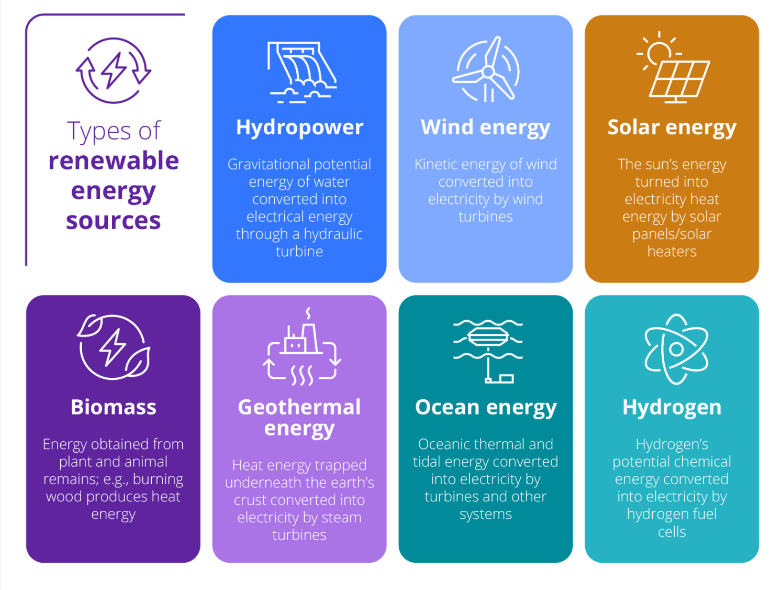7 August 2024 : Indian Express Editorial Analysis
1. Realpolitik can be green
(Source: Indian Express; Section: The Ideas Page; Page: 17)
| Topic: GS3– Environment |
| Context: |
|
What is Green Energy?
- Green energy is defined as energy derived from renewable sources. It is also known as clean, sustainable, or renewable energy.
- Green energy generation emits no dangerous greenhouse gases into the atmosphere, resulting in little or no environmental impact.
- Solar, wind, geothermal, biogas, low-impact hydroelectricity, and certain qualified biomass sources are all key green energy sources.

Varying State-Led Transitions
- India’s green energy transition is not a monolithic national endeavor but rather a mosaic of state-led initiatives.
- Different states are at various stages of progress, driven by unique policy environments, demographics, and economic conditions.
- For instance, states like Telangana, Tamil Nadu, Kerala, Odisha, and Delhi have advanced more rapidly due to favorable policies and demographics.
- Conversely, states like Haryana lag despite supportive policies, primarily due to inadequate implementation mechanisms.
- Financial constraints have also hindered progress in states like Rajasthan.
- The lack of uniformity in the transition highlights the need for a cohesive approach that aligns central and state efforts, ensuring that political and institutional boundaries do not impede progress.
Tensions Between Transition Drivers and Trade Policy
- The intersection of green energy transition drivers and trade policy reveals significant tensions.
- A major policy dilemma is the role of China in the clean energy market. China’s dominance in renewable energy components and manufacturing raises questions about the extent to which India should rely on Chinese imports to accelerate its transition.
- While allowing Indian manufacturers access to cheaper Chinese products could narrow the competitiveness gap between clean energy and fossil fuels, it also poses national security risks due to potential over-dependence on China.
- Additionally, proposed carbon taxes by the US, EU, and UK on imported goods challenge India’s ability to balance sustainability, national security, and economic growth. Aligning trade and climate policies is essential to navigate these complexities.
Governance and Ethical Imperatives
- The ethical imperative of sustainable development often clashes with the realpolitik of governance.
- Climate change’s tangible impacts, such as forest fires in Uttarakhand, extreme temperatures in Leh, and landslides in Wayanad, underscore the urgency of addressing global warming.
- However, governance structures remain mired in rigid, self-serving nationalisms, impeding cooperative efforts to tackle the crisis.
- Former US Secretary of State Henry Kissinger noted the difficulty of reconciling national interests in win-win outcomes, a notion that is particularly relevant in the context of climate change.
- A shift in perspective is necessary, one that prioritizes humanity, ethics, and cooperative governance over narrow realpolitik to effectively address the global challenge of climate change.
| Why is the Green Energy Transition Significant for India? |
|
Combating Climate Change and Air Pollution: India is the third largest emitter of greenhouse gasses after China and the US.
Energy Security and Import Dependence: India is likely to account for 25% of global energy demand growth over the next two decades exposing the country to price fluctuations and geopolitical tensions.
Attracting Investments and Global Leadership: The global focus on sustainability is attracting significant investments in green technologies.
|
| PYQ: Access to affordable, reliable, sustainable and modern energy is the sine qua non to achieve Sustainable Development Goals (SDGs). Comment on the progress made in India in this regard. (150 words/10m) (UPSC CSE (M) GS-3 2018) |
| Practice Question: Discuss the role of the central and state governments in India’s green energy transition. How can better coordination and structural redesign help achieve the nation’s renewable energy goals? (250 words/15 m) |
2. The Rawalpindi factor
(Source: Indian Express; Section: The Ideas Page; Page: 17)
| Topic: GS2– International Relations – India and it’s neighbourhood |
| Context: |
|
Internal and External Relevance
- The constitutional changes in Kashmir, enacted five years ago, present a complex picture regarding their impact on India-Pakistan relations.
- On one hand, by ending the ambiguity in Jammu and Kashmir’s (J&K) relationship with India, Delhi has firmly asserted that its internal status is not open-ended or negotiable.
- This has diminished Pakistan and China’s efforts to internationalize the Kashmir issue. On the other hand, the issue remains relevant in the context of India-Pakistan conflict, as evidenced by the surge in cross-border terrorism coinciding with Narendra Modi’s third term as Prime Minister.
- Despite legal formalism, Pakistan’s capacity to meddle in Kashmir persists, necessitating vigilance from Delhi.
Reducing Global Salience
- Delhi has made significant strides in reducing the international prominence of the Kashmir question.
- Since taking the issue to the United Nations in 1948, international dimensions have heavily influenced India’s Kashmir policy. The 1972 Simla Agreement between India and Pakistan did not eliminate third-party roles.
- The Pakistan Army’s renewed efforts to internationalize the issue during the late 1980s’ turbulence, along with the post-Cold War focus on human rights and political devaluation of state sovereignty, provided Pakistan with a dual strategy to support insurgency in Kashmir and demand global intervention.
Diplomatic Maneuvering and Military Strategy
- The end of the Cold War, and the subsequent global human rights agenda, increased international pressure on India, compounded by concerns over nuclear proliferation.
- In the 1990s, Kashmir was often labeled the world’s “most dangerous nuclear flashpoint.” The ensuing challenges of cross-border terrorism, internal unrest, and international scrutiny were daunting for India’s politically unstable coalition governments.
- However, steady economic growth and improved US relations in the 2000s helped India mitigate these pressures.
- The George W. Bush administration ceased Washington’s Kashmir activism, resolving the nuclear dispute with India, although Pakistan’s cross-border terrorism remained a significant issue.
Constitutional Change and Its Aftermath
- The Modi administration, with a clear objective to renegotiate terms with Pakistan, enhanced military deterrence, ended engagement with militant groups in Kashmir, and insisted that talks and terror could not coexist.
- The August 2019 constitutional change in Kashmir was a capstone of this strategy.
- However, Pakistan’s reaction, supported by China, attempted to place the issue on the UNSC agenda, which India countered with support from the US, France, UAE, and Saudi Arabia.
- India’s new partnerships in the West and the Islamic world, coupled with its economic ascendancy, have weakened Pakistan’s stance.
Future of India-Pakistan Engagement
- Despite India’s recent successes, complacency is not an option. Pakistan’s internal political divisions and economic struggles have lessened its threat, but the Pakistan Army remains a potent force.
- Renewed political trouble in Kashmir will inevitably draw international attention.
- Therefore, India must focus on internal reconciliation in Kashmir, counter cross-border terrorism, and engage with diverse elements of Pakistan’s polity.
- Only through a multi-faceted strategy can India navigate the complex dynamics of its relationship with Pakistan and ensure long-term stability in the region.
| Practice Question: Critically analyze the impact of the constitutional changes in Jammu and Kashmir on India-Pakistan relations over the past five years. How have these changes influenced both domestic and international dynamics, and what challenges and strategies should India consider moving forward? (250 words/15 m) |





